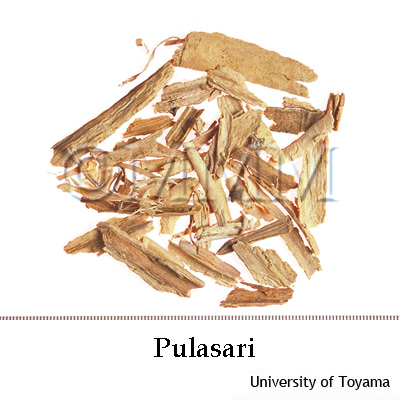Crude drug sample data base
※Click on the image to enlarge it.
Scientific information data base
| Crude drug name | Indonesian name, English name | Kulit kayu pulosari | ||||
|---|---|---|---|---|---|---|
| crude drug image |
| |||||
| Original plant name | Alyxia reinwardtii Blume | |||||
| Family name | Apocynaceae | |||||
| Distribution area | It occurs throughout Indonesia in the montane forests [201]. | |||||
| Description | The bark is fragrant and the smell may last up to 2 years but its bitter taste will soon disappear; white in colour and look similar to licorice. The plant is a ground creeper or climber; leaves opposite or in whorls of 3-5, elliptical, glabrous or puberulent; inflorescence axillary or terminal; 3-12 flowered; corolla tube columnar, white, cream, yellow, pink, white with orange tube. Fruit with 1-2 articles in each string, ellipsoid or globose, maturing black [201, 220]. | |||||
| Drug effect | Pungent, bitter, warming, improving blood circulation [231]. | |||||
| Specific actions | Anti-spasmodic, tonic to stomach [201, 231] | |||||
| Frequency in use | Abundant | |||||
| Common uses | Bundles of dried twigs of A. reinwardtii can be placed in cupboards to perfume clothes and the fragrant smell may last up to two years. Dried and finely powdered bark is used as an ingredient in the manufacture of incense in Java [220]. | |||||
| Pharmacological effect | Coumarin isolated from Alyxia reinwardtii exhibits antispasmodic activity. It showed less inhibition of contraction induced by phenylephrine and noradrenaline than that of microminutin, a new member of the simple coumarin. | |||||
| Medical system | Indonesian medicine (Jamu) | |||||
| Traditional usage | It is used to treat gastritis, fever, spasm of the abdomen. [201]. The bark is widely used as an ingredient in Javanese traditional medicine formula accompanied by fennel seeds and popularly known as ''adas pulosari''. Probably the combination is meant to impart flavour and pleasant odour to the other ingredients, as fennel seeds are sweet and aromatic. Adas pulosari is used in various sorts of manufactured ''jamu'' from Central Java as a principle ingredient. These are used as an antispasmodic, for the treatment of stomachache, flatulence, colic, fever, and a good remedy for mouth ulcer [201, 220]. The bark is considered a good remedy for colic of the abdomen and fever. A typical combination of the bark with a certain type of banana, locally called ''pisang batu'' (pisang = banana, batu = stone) is popularly used for thrush. Banana, fennel seed, bark of A. reinwardtii and a small amount of water are smashed, and the juice obtained is drunk . The wood is pounded to make a porridge which has cooling property and is rubbed for treating fever, especially in children [201]. | |||||
| Formulation | 1) Mouth ulcer and stomachache - Ingredients: 1 teaspoon of powdered bark, 10 pieces of fennel seed (powdered), 2 slices of riped ''pisang batu'' (literally: stone banana), 2 slices of half-riped ''pisang batu'' . - Preparation: steep powdered bark and fennel in hot water. Add the bananas, smashed and mixed all together, and squeeze. Drink the juice once a day, and repeat for 14 days. | |||||
| References | Reference book Tips! | [201] K. Heyne, Tumbuhan Berguna Indonesia, Vols. 1-4, 1987. Diedarkan Oleh Koperasi Karyawan Departemen Kehutanan, Jakarta, Indonesia. Vol. 3, pp 1636-1637. [220] van Valkenburg, J.L.C.H. and Bunyapraphatsara, N. (editors). Plant Resources of South-East Asia No. 12 (2). Medicinal and posionous plants 2. Prosea Foundation, Bogor, Indonesia, 2002. pp 69-72. [231] Soedibyo, Mooryati: Alam Sumber Kesehatan: Manfaat dan Kegunaan (Natural resources for health. Benefits and uses). Balai Pustaka. 1998. pp 311-312. | ||||
| Remarks | [DNA sequences] DQ660496, DQ660627, DQ660559, DQ660681, DQ660749 The trade in pulasari for ''jamu medicine'' in Central Java is increasing by about 15% a year. In 1990 63t were used and this will probably have risen to about 180t in 2000 [220]. | |||||
| Last renewal date | 2024/03/08 | |||||







